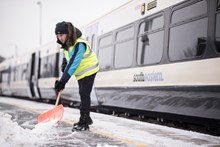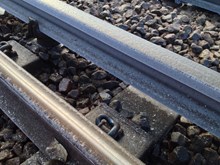“When the mercury plummets, even the lightest shower of rain or dusting of snow can freeze on the rails, preventing trains from drawing power or being able to move with any speed. And in the worst cases, it stops them from being able to move at all.”
That’s the message from Network Rail south east’s managing director John Halsall as we launch our annual winter campaign to reduce the impact on services and challenge the long-standing misconception that ice on the tracks is a rail industry excuse.
“Snow and ice also causes points - which allow trains to move between tracks - to freeze solid or get jammed with compacted snow. When this happens, trains can’t safely run over them” added John.
“The couplers that join carriages together can also become iced up, making it difficult to join them together, or split them apart, reducing the number of trains we have available,” said Southeastern’s Managing Director David Statham.
“We know our passengers have places to go and together with Network Rail we’ve been preparing for winter for months in advance. And it’s why during the most difficult conditions, we change to a Winter Weather or Severe Winter Weather Timetable to keep trains running,” added David.
Working with train operators Southeastern and Govia Thameslink Railway, our ice-and-snow-busting trains will travel the equivalent of six times around the world in the south east, anti-icing the rails to keep passengers moving when winter weather strikes. These special trains lay anti-icing fluid to stop the electric rail freezing up and have snow ploughs when weather is severe.
In addition, Network Rail has:
- Fitted points which are most likely to freeze with heaters and NASA-grade insulation to prevent ice forming and them sticking in place.
- Installed conductor rail heating in areas prone to freezing.
- This year, Network Rail is trialling a more effective anti-icer fluid on the Sheerness line, which contains more of the active ingredient that stops ice forming.
- Adjusted its extreme weather forecasting processes to better predict ice build-up on the conductor rail.
- Set up to receive detailed forecasts from weather experts MetDesk to help formulate local action plans during adverse weather, minimising disruption to passengers. The forecasts cover not just the weather but how the conditions will impact on specific railway infrastructure such as the tracks and conductor rails. A network of hundreds of monitoring stations also provides real-time weather data, enabling Network Rail to respond to conditions as they develop in real time.
In addition, Southeastern will:
- Run empty ‘ghost trains’ overnight to keep tracks and overhead cables free of snow and ice.
- Train all new Southeastern drivers at a one-day low adhesion training course, using simulators at our Learning & Development Centres in Ashford and Orpington, and continue to support with Driver Managers and Instructors during severe and adverse conditions, issuing a Seasonal Briefing booklet to all drivers containing winter driving policy and other helpful advice.
- Ensure that its station teams are ready to go with gritting and snow-clearing.


